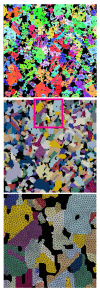Many-Scale Investigations of Deformation Behavior of Polycrystalline Composites: II-Micro-Macro Simultaneous FE and Discrete Dislocation Dynamics Simulation
- PMID: 35454544
- PMCID: PMC9031853
- DOI: 10.3390/ma15082852
Many-Scale Investigations of Deformation Behavior of Polycrystalline Composites: II-Micro-Macro Simultaneous FE and Discrete Dislocation Dynamics Simulation
Abstract
The current work numerically investigates commercial polycrystalline Ag/17vol.%SnO2 composite tensile deformation behavior with available experimental data. Such composites are useful for electric contacts and have a highly textured initial material status after hot extrusion. Experimentally, the initial sharp fiber texture and the number of Σ3-twins were reduced due to tensile loading. The local inhomogeneous distribution of hardness and Young's modulus gradually decreased from nanoindentation tests, approaching global homogeneity. Many-scale simulations, including micro-macro simultaneous finite element (FE) and discrete dislocation dynamics (DDD) simulations, were performed. Deformation mechanisms on the microscale are fundamental since they link those on the macro- and nanoscale. This work emphasizes micromechanical deformation behavior. Such FE calculations applied with crystal plasticity can predict local feature evolutions in detail, such as texture, morphology, and stress flow in individual grains. To avoid the negative influence of boundary conditions (BCs) on the result accuracy, BCs are given on the macrostructure, i.e., the microstructure is free of BCs. The particular type of 3D simulation, axisymmetry, is preferred, in which a 2D real microstructural cutout with 513 Ag grains is applied. From FE results, Σ3-twins strongly rotated to the loading direction (twins disappear), which, possibly, caused other grains to rotate away from the loading direction. The DDD simulation treats the dislocations as discrete lines and can predict the resolved shear stress (RSS) inside one grain with dependence on various features as dislocation density and lattice orientation. The RSS can act as the link between the FE and DDD predictions.
Keywords: crystal plasticity; discrete dislocation dynamics; dislocation mechanisms; local yield stress; many-scale simulation; texture; Σ3-twins effect.
Conflict of interest statement
The authors declare no conflict of interest.
Figures

















References
-
- Lu X., Zhang X., Shi M., Roters F., Kang G., Raabe D. Dislocation mechanism based size-dependent crystal plasticity modeling and simulation of gradient nano-grained copper. Int. J. Plast. 2019;113:52–73. doi: 10.1016/j.ijplas.2018.09.007. - DOI
-
- Konijnenberg P., Zaefferer S., Raabe D. Assessment of geometrically necessary dislocation levels derived by 3D EBSD. Acta Mater. 2015;99:402–414. doi: 10.1016/j.actamat.2015.06.051. - DOI
-
- Zaafarani N., Raabe D., Singh R., Roters F., Zaefferer S. Three-dimensional investigation of the texture and microstructure below a nanoindent in a Cu single crystal using 3D EBSD and crystal plasticity finite element simulations. Acta Mater. 2006;54:1862–1876. doi: 10.1016/j.actamat.2005.12.014. - DOI
-
- Okabe A., Boots B., Sugihara K. Spatial Tessellations: Concepts and Applications of Voronoi Diagrams. John Wiley; Chichester, UK: 1992. - DOI
Grants and funding
LinkOut - more resources
Full Text Sources
Research Materials

